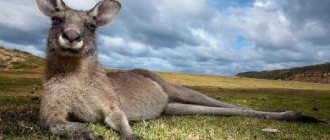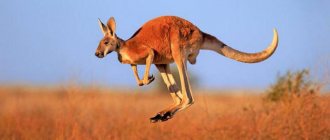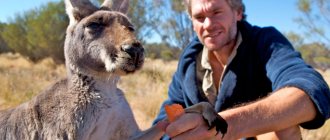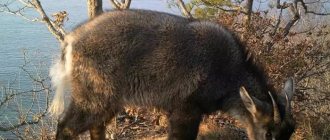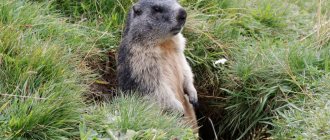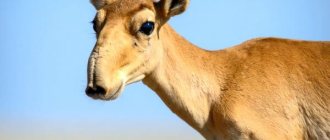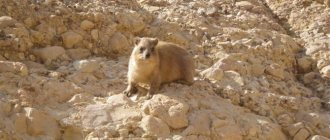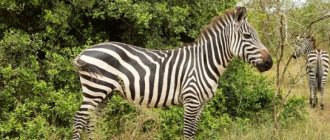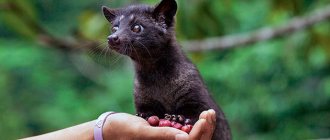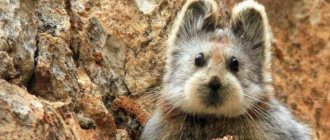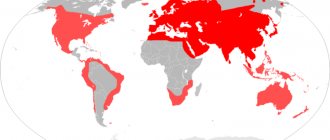Kangaroo: description
The name kangaroo comes from the name of an interesting animal by the Australian Aborigines. In fact, there are several versions of the name of this animal. According to one of them, when local aborigines were asked what kind of animal this was, they answered “ken-gu-ru,” which translated means “we don’t know.” Nowadays, this animal is considered an unofficial symbol of Australia and its image is present on the coat of arms of this state.
Appearance
Depending on the species of animals, their size and weight vary widely. The body length of adult individuals can range from 0.25 to 1.5 meters, with a weight from 18 to 100 kilograms. The red kangaroo is considered the largest member of the family, and the eastern gray kangaroo is the largest. The kangaroo's coat is quite thick, but soft, and can be black, gray or red in color, as well as variations of these shades.
Interesting to know! The body structure of these animals allows them to actively resist enemies with the help of their hind limbs, as well as quickly move over rough terrain, using their tail as a rudder.
A kangaroo is an animal with a relatively poorly developed upper body, while its head is relatively small, while the shape of the muzzle can be either elongated or shortened. In addition, this unique animal has a narrow shoulder girdle, short and poorly developed forelimbs, which are practically not covered with hair and have 5 fingers, armed, although short, but rather sharp claws. The fingers are quite mobile, which allows the mammal to grab and hold various objects, comb its fur, and also help in feeding.
The lower part of the body is quite developed, and it is worth paying attention to the powerful hind legs, a long, reliable and thick tail, as well as strong and muscular thighs. The hind limbs of the kangaroo are armed, in comparison with the front ones, not with five, but with four fingers. The second and third fingers are connected by a membrane, and the fourth finger is armed with a strong and sharp claw.
Behavior and lifestyle
Kangaroos prefer to be nocturnal, so after sunset they head to their pastures. During the daytime, they can be found resting in the shade of trees, in grass nests or in special burrows. In case of serious danger, they hit the surface of the ground with all their hind legs to convey this signal to their relatives. In addition to this method of transmitting information, kangaroos communicate with each other using special types of sounds, in the form of grunting, sneezing, clicking and hissing.
Interesting to know! Almost all types of kangaroos are characterized by attachment to certain territories. In this regard, they do not leave them without special reasons. As for large red kangaroos, they make many-kilometer migrations in search of more comfortable living conditions.
These mammals can form large groups of up to hundreds of individuals, especially in comfortable conditions, when there is enough food and practically no natural enemies. They mostly live in small groups, including a male, several females and their offspring. Males constantly ensure that no outside adult males penetrate into their harem. If this happens, the male will face a very fierce fight.
How long do kangaroos live?
The red kangaroo is considered the longest-liver of this family, as it can live for almost 25 years. In general, life expectancy depends both on the species and on the living conditions.
According to these data, the eastern gray kangaroo ranks second. When in captivity, this species can live for about 2 decades, but when in the wild, it can live no more than 12 years. Western gray kangaroos have the same characteristics.
KANGAROO - INTERESTING FACTS
Types of kangaroos with photos
Today, more than 50 species of kangaroos are known, although only medium- and large-sized animals are considered true kangaroos.
There are only a few of the most famous species:
Great red kangaroo (Macropus rufus)
grows in length to almost 2 meters, therefore it is considered the longest representative of the family. The length of the tail of adult individuals reaches about 1 meter, or even more. The weight of an adult male can be about 85 kilograms, and the weight of females can be no more than 35 kilograms.
Forest gray kangaroo (Macropus fuliginosus)
It is distinguished by its large weight (about 100 kilograms), therefore it is considered the most massive species. The body length of the animal reaches an average of 170 centimeters.
Mountain kangaroo (Macropus robustus)
It is a fairly large animal, but somewhat different from other species in its physique. This is a short animal with broad shoulders and relatively short hind legs. The area around the nose is not covered with hair, while the lower part of the paws is rough, which allows the kangaroo to move easily over mountainous terrain.
Tree kangaroo (Dendrolagus)
This is the only member of the family that lives in trees. The body length of the animal is within half a meter or a little more. This species has fairly thick fur of a brownish tint. This animal easily climbs trees, thanks to the presence of very tenacious claws. The brownish tint of the coat allows the animal to easily camouflage itself while in the treetops.
Wallaby
It is considered the smallest kangaroo in this family. They grow no more than half a meter in length, weighing about 1 kilogram. In appearance, these animals are more reminiscent of ordinary rats, with a hairless and long tail.
Interesting moment! Kangaroos, regardless of the variety, have excellent hearing, so animals pick up the slightest sound vibrations. Because of their tail, kangaroos cannot move backwards, but they are excellent swimmers.
Natural habitats
Kangaroos mainly live in Australia and Tasmania, New Guinea and the Bismarck Archipelago. These animals were once brought to New Zealand. Kangaroos prefer to settle close to human habitation, so they can easily be found near densely populated or small cities, as well as near farmland.
The main part of kangaroo species prefers to lead a terrestrial lifestyle, preferring to live within flat areas overgrown with dense grass or shrubs. As for tree kangaroos, they are not poorly adapted to living at altitude. Mountain wallabies prefer to live in mountainous areas.
What do kangaroos eat?
The basis of the kangaroo's diet is plant food, in the form of a variety of plants, grasses, clover, alfalfa, flowering legumes, eucalyptus and acacia leaves, vines and ferns, including roots and tubers of all kinds of plants, fruits and berries. Some species happily eat worms and also insects for variety.
As far as is known, adult males feed about 1 hour longer than females, but females eat more nutritious components, with a high level of protein. This factor has a serious impact on the quality of milk produced.
Important point! Kangaroos are interesting and resourceful animals, so they easily adapt to various unfavorable natural conditions, including the lack of a usual diet. Therefore, they easily switch to other types of food supply. At the same time, they are able to eat plants that can be considered edible only conditionally.
Natural enemies
Being in the natural environment, kangaroos feed once a day, waiting until sunset. This also significantly reduces the risk of these mammals encountering their natural enemies. Kangaroos are mainly hunted by dingoes, foxes, and some species of large birds of prey.
Versus! Kangaroo vs man and dog!!!
Nutrition
Plant food is the daily diet of kangaroos. Herbivores chew their food twice, like ruminants. First they chew, swallow, and then regurgitate a small part and chew again. The animal's stomach contains a special type of bacteria that greatly facilitates the digestion of tough plant foods.
Kangaroos living in trees naturally feed on leaves and fruits growing there. Kangaroos, belonging to the rat family, prefer fruits, roots, and plant bulbs, however, they also like insects. Kangaroos cannot be called water-drinkers, because they drink very little and can do without life-giving moisture for a long time.
Kangaroo and man
It cannot be said that the kangaroo is such a dangerous animal that meeting it is fraught with mortal danger, especially since in the media this animal is positioned as friendly. Despite this, these animals, under certain conditions, can cause serious harm to human health. It should always be remembered that this is a wild animal, although the risk of attack is very low and is associated with a number of factors. Facts indicate that quite a few victims of encounters with kangaroos go to doctors throughout the year.
Kangaroos can attack a person in the following cases:
- As a result of exposure of a group of animals to various external factors.
- Constant contact with people leads to the animal losing its sense of fear.
- In case of a real threat to the animal or its offspring.
- The animal has no choice but to defend itself.
- A person interferes with the living space of a kangaroo.
- A domesticated kangaroo may be aggressive in the initial stages.
In the event of an attack on a person, the animal uses both its front and hind limbs, while using the kangaroo's tail as a support. Hitting, especially from the hind legs, is quite dangerous, and the injuries resulting from such kicks can be quite serious.
Interesting Facts
These animals have many skills that would make them excellent candidates for the Olympic Games. With such a varied Australian landscape, they had to adapt to a variety of challenges to fend off predators, quickly cover large areas and find food in barren terrain.
In Australia there are more kangaroos than people. They are the national symbol of the state, and their image is present:
- on the country's coat of arms;
- on postage stamps and coins;
- on airplanes.
On land, kangaroos move their hind legs together, but in water they move each leg separately. Females can determine the sex of their offspring and delay pregnancy when environmental factors reduce the likelihood of survival of the young.
These animals have excellent hearing. Like some other animals, they can move their ears in different directions. Kangaroos are social animals that live in groups of 3 or 4 individuals. Some groups can include up to 100 pieces.
Reproduction and offspring
After one and a half or 2 years of life, individuals become sexually mature, ready for reproduction. The ability to reproduce remains for 10-15 years. The reproduction process is carried out once a year, and it makes no sense to talk about which season is decisive. The pregnancy process lasts about a month and a half, after which the female gives birth to one or two cubs.
After mating of the Macropus rufus species, as a rule, 3 kangaroo chicks are born. The cubs are born, about 2 and a half centimeters long. After birth, the female carries her offspring in her pouch for about 8 months, and sometimes longer.
Interesting to know! In many species, embryos have a delay in their development, so a very small and blind kangaroo immediately crawls into the mother’s pouch, where it can remain in a state of development for almost a year, or even more.
Animals mate without problems within a few days after the birth of their offspring. Swamp wallabies - about a day before the birth of offspring, and the embryo does not develop until the previous offspring is fully grown. After this, the embryo begins its development. If conditions are very favorable, then new offspring may be born immediately after the previous offspring finally leaves the mother's pouch.
Range, habitats
The main habitat of the kangaroo is represented by the territory of Australia and Tasmania, New Guinea and the Bismarck Archipelago. Marsupials were also introduced to New Zealand. Kangaroos quite often settle close to people's homes. Such marsupials can easily be found on the outskirts of not too large and densely populated cities, as well as near farms.
As observations show, a significant part of the species are terrestrial animals that live on flat areas covered with dense grass and shrubs. All tree kangaroos are perfectly adapted to moving through trees, and mountain wallabies (Petrogale) live directly in rocky areas.
Return to content
Population and species status
The major known kangaroo species are not considered to be at risk of extinction. And yet, it should be noted that the number of marsupials is constantly declining, which is associated with the active development of fertile soils. This leads to animals being deprived of their natural habitat.
Australian laws protect species such as the Eastern and Western gray kangaroos because the wild animals are hunted for their pelts and meat. These animals also get it when they appear on the territory of farms.
It is believed that kangaroo meat is very beneficial for the human body, since it is considered dietary due to its low fat content. Nowadays, these animals have been given the conservation status of “having the lowest risk of extinction.”
What can koalas do?
They know how to swim. The slowness of the koala is associated with the characteristics of its diet. It has adapted to feed almost exclusively on eucalyptus shoots and leaves, which are fibrous and low in protein, but contain many phenolic and terpene compounds that are poisonous to most animals.
Interesting materials:
How to give Ospamox? How to give yourself an admin account on your MTA server? How to give constructive criticism? How are carbonated drinks made? How are speed bumps made? How are balls made? How is real champagne made? How do you make a rank book? How are bowling balls made? How is Kikkoman soy sauce made?
Enemies
In the wild, the red kangaroo has few enemies: dingoes, foxes and birds of prey. If necessary, the marsupial can perfectly stand up for itself, using fighting techniques with the help of its hind legs. They successfully escape, reaching speeds of up to 60 kilometers per hour.
The main enemy of the kangaroo is man. Farmers and livestock breeders use various methods to combat pesky animals that eat pastures. The Australian red kangaroo is of great interest to hunters - its dietary meat is rich in proteins and contains only 2% fat. The skin is used to make clothes, shoes and other products.
